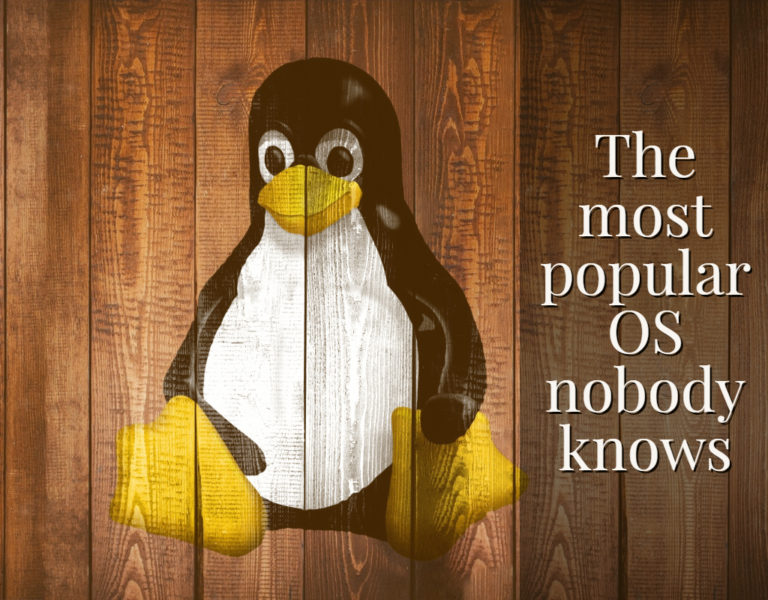The Most Popular OS Nobody Knows
If you asked a non-techie which PC operating systems they were familiar with, most will mention either Windows or Mac OS. Similarly on the mobile side of things, people know Android or iOS. In this post, I want to discuss the so called underdog in this race. I am, of course, referring to the Linux operating system. What started in 1991 as a project to create the kernel of an operating system by a computer science student named Linus Torvalds soon gathered incredible momentum with hundreds of programmers from around the world pitching in to help build on that project and culminate in what is now a robust, mature and modern operating system.
My first encounter with this OS was in 1996 when India’s most popular computer magazine, PC Quest, distributed a copy of the Slackware Linux distro on their cover CD. They also had an in-depth article about the OS and its features. I lost no time in setting up Linux on a partition of my PC hard-drive and exploring it. Getting it up and running took a lot of trial and error which I was happy to do but I doubted if a regular computer user would bother with the hassle. Even though Linux at that time had a Graphical User Interface (GUI), it looked crude and primitive when compared to the mainstream OSes like Windows or Mac. Plus, you didn’t get a GUI during the installation process. It was completely command-line based with cryptic commands you needed to enter and equally cryptic error messages that would be shown if something went wrong along the way (which was often). Once you got the OS installed, you then followed an equally complicated process to get the GUI which was called “X-Windows” set up.

The ‘very user friendly’ installation screen for Slackware Linux
Over the following years, I watched Linux get more popular but never gaining a foothold in the mainstream PC user base. However, it did gain a lot of fans on the internet with most websites running a flavour of Linux on their servers. There were some attempts to make a Linux distro that would bridge the usability gap between it and Windows. One example that comes to mind was a distro called “Lindows” in 2001. This was a commercial distro that did an admirable job of creating the most user-friendly version of Linux at that time. It came with a full GUI installer and a look-and-feel that was almost a copy of Windows XP (the popular version of Windows at that time). However, it was sued by Microsoft as soon as it came to market and forced to change their name to “Linspire”. After that, it dropped off the radar and never made a difference.

The Lindows OS desktop
The distro that really got Linux some popularity among the masses would be Ubuntu. Started in 2004 by a company called Canonical, it became popular in a short time and continues to have a sizeable fan following till today. Meanwhile on the mobile side, Apple was working in secret on their revolutionary product soon to be revealed as the iPhone. But several attempts were made by some of the other cell-phone manufacturers to create smartphones based on the Linux OS. I remember my brother, Vikram, owning a couple of Motorola phones that ran Linux. Those phones never gained widespread popularity and remained niche devices.
In 2007, Apple launched the iPhone and completely changed the mobile phone industry overnight. All the major phone manufacturers were like deer in headlights and scrambled to come up with something compelling that would keep them in the race. The very next year, Google released the first smartphone with their new mobile operating system that would be free and available to all the manufacturers. The rest is history as Android quickly gained popularity with hundreds of smartphone models flooding the market from all the major smartphone manufacturers. Today, Android is the dominant mobile operating system with over 75% market share worldwide. However, many of its users would be unaware that Android is actually a heavily customized version of Linux. This means most of us are now Linux users without realizing it, which led me to the title of this blog post.
If you have an Android device, you are also a Linux user.
Today Linux is the operating system that runs on most of the servers that comprise the “cloud”. It also has made a lot of inroads into the enterprise which was earlier completely dominated by Windows. I am sure Linux will continue to grow it’s base and eventually gain popularity among the mainstream PC users in the future. Meanwhile, if reading this article has generated any curiosity in you to try out this operating system, I would be the first one to nudge you along that path. Whether you are a Windows or a Mac user, you can find a Linux distro that will make you feel at home. I am listing some of my favourite distros that you can check out. Hope you have fun exploring Linux.
For Windows users: https://sites.google.com/site/chaletoslinux/home
For Mac users: https://elementary.io/
For anyone: https://linuxmint.com/
Vinayak Nair is a self-confessed geek from the days when computer memory was measured in Kilobytes. I create YouTube videos on 3D Printing, DIY Projects, Everyday tech reviews and also delve into gaming.

